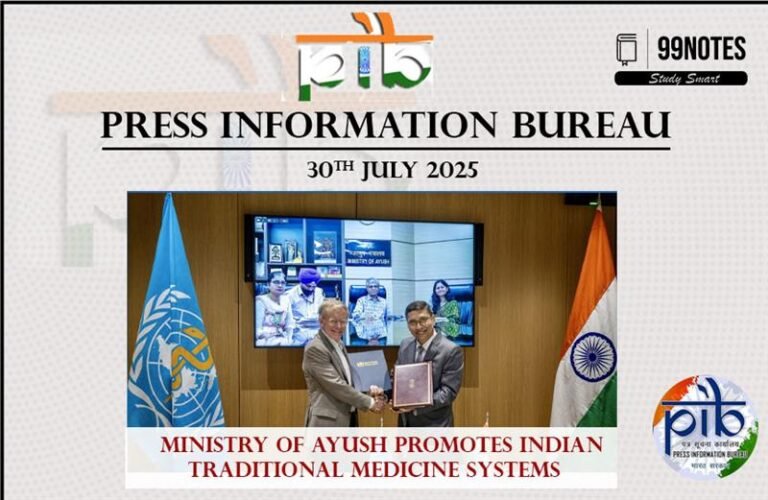12 August 2024 : Daily Current Affairs
1. Union Cabinet Approves Clean Plant Programme to Boost Horticulture Yield and Quality in India
- 1. Union Cabinet Approves Clean Plant Programme to Boost Horticulture Yield and Quality in India
- 2. Technical Snag Extends Astronauts’ Stay at ISS Until February 2025
- 3. PM releases 109 high yielding, climate resilient and biofortified varieties of crops
- 4. Cold War nuke tests light up a bug in present-day climate models
- 5. On amendments to the Waqf Act
- 6. Biotechnologists detect difference in use of nitrogen by rice varieties
- Prelims Facts
- 1. Perseid meteor shower
- 2. What is a tactical index fund
- 3. Japan Issues First-Ever Megaquake Advisory After 7.1-Magnitude Quake Hits Southern Region
(Source: Indian Express; Section: Explained; Page: 13)
| Topic: GS3 – Agriculture |
| Context: |
| The Union Cabinet has approved the Clean Plant Programme (CPP) to boost the yield, productivity, and quality of horticulture crops in India. |
Analysis of News:

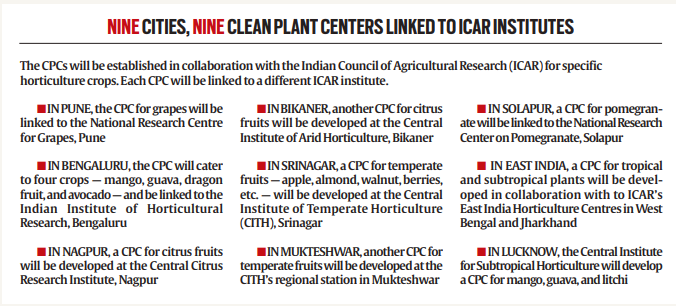
About CPP
- The CPP, first announced in the 2023 interim Budget, aims to enhance fruit crop quality across the nation with a budget of Rs 1,765 crore, partially funded by the Mission for Integrated Development of Horticulture (MIDH) and a loan from the Asian Development Bank (ADB).
Key Components of the CPP
- Clean Plant Centers (CPCs): Establishment of nine CPCs to provide disease diagnostics, create mother plants, and quarantine domestic and imported planting materials.
- Infrastructure Enhancement: Development of large-scale nurseries to multiply and distribute clean planting material to farmers.
- Regulatory and Certification Processes: Implementation of stringent certification and traceability mechanisms for planting materials.
Rationale for the CPP
- India, the second-largest producer of fruits and vegetables globally, has seen a significant increase in horticulture area and production over the past decade.
- The rising demand for high-quality and exotic fruits, including foreign apples, avocados, and blueberries, underscores the need for the CPP.
- The programme aims to streamline the currently cumbersome import process, reducing quarantine periods from two years to six months, and ensuring farmers have access to disease-free, high-quality planting material, akin to successful models in the US, Israel, and the Netherlands.
| Key Benefits of the Clean Plant Programme (CPP) |
|
1. For Farmers: Farmers will get access to virus-free, high-quality planting material. This will lead to better crop yields and higher income opportunities. 2. For Nurseries: Nurseries will benefit from easier certification processes and better infrastructure support.This will help them grow and distribute clean planting materials efficiently. 3. For Consumers: Consumers will enjoy better-tasting, virus-free fruits with improved nutritional value. 4. For Exports: The production of high-quality, disease-free fruits will strengthen India’s position as a top global fruit exporter, opening up more international market opportunities. 5. Inclusive Approach: The programme will ensure that all farmers, regardless of their land size or economic status, can access clean plant material. Special focus will be given to involving women farmers in planning and implementing the programme, giving them access to resources and training. 6. Region-Specific Development: The programme will develop clean plant varieties and technologies suited to different agro-climatic conditions across India. |
| Practice Question: Discuss the significance of the Clean Plant Programme (CPP) recently approved by the Union Cabinet in enhancing horticulture productivity and quality in India. How does the programme address the challenges faced by Indian farmers in accessing disease-free and high-quality planting material? (250 words/15 m) |
2. Technical Snag Extends Astronauts’ Stay at ISS Until February 2025
(Source: Indian Express; Section: Explained; Page: 13)
| Topic: GS3 – Science and Technology |
| Context: |
|
Analysis of News:
About the International Space Station
The International Space Station (ISS) is the largest man-made object in space launched on November 20, 1998. It serves as a habitat for astronauts in space. Since 2011, the ISS has been continuously inhabited.
- Participating States: ISS is a collaborative project of the United States (NASA), Russia’s (Roscosmos), Europe’s (ESA), Japan’s (JAXA), and Canada’s (CSA) space agencies.
- Orbit: The International Space Station is in orbit about 400 kilometres above Earth.
- Speed: It travels around Earth at a speed of about 28,000 kilometres per hour. This means that it orbits Earth about every 90 minutes.
- Objectives: To expand our knowledge about space and microgravity and promote new scientific research. It also serves as an example of international cooperation.
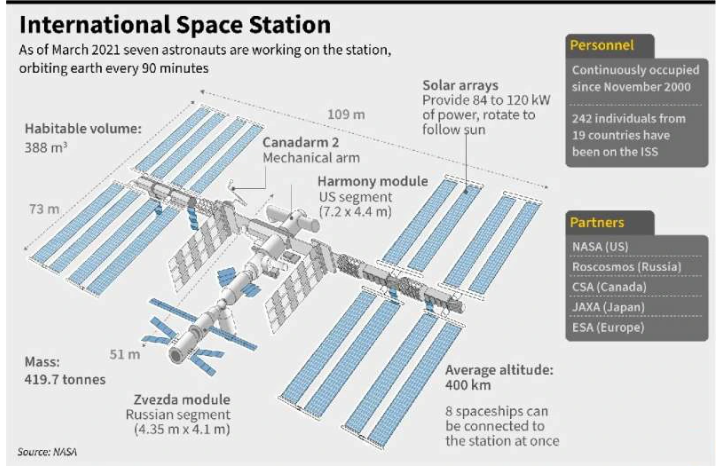
About Boeing Starliner
- Starliner is a spacecraft that transports astronauts into space after being launched there by a rocket.
- It consists of a crew capsule and a service module.
- The crew capsule houses the astronauts; like others of its kind, it will be able to survive reentry and return to the ground.
- The service module consists of the equipment and systems the astronauts need to survive in space, including air and temperature control, water supply, sanitation, etc., plus the engines and fuel required to manoeuvre the spacecraft.
- The service module won’t be reusable.
- Starliner is more than 4 meters wide and can house up to seven astronauts.
- The Starliner has an innovative, weldless structure and is reusable up to 10 times with a six-month turnaround time.
- It also features wireless internet and tablet technology for crew interfaces.
- It can be fit atop an Atlas V rocket, operated by United Launch Alliance, a joint venture between Boeing and Lockheed Martin.
What is Starliner’s purpose?
- On September 16, 2014, NASA announced it had awarded contracts to SpaceX and Boeing to fly astronauts to the International Space Station (ISS).
- Since being awarded the NASA contracts, SpaceX has flown 13 missions to the ISS onboard its Dragon crew capsule (which can also house seven astronauts).
- After NASA shut its Space Shuttle programme in 2011 and before SpaceX’s Dragon capsule got ready in 2020, only Russia’s Soyuz rocket and capsule could ferry astronauts to and from the ISS.
- SpaceX and Boeing will take turns launching astronauts to the ISS—each crew’s expedition lasts up to six months—until the ISS is decommissioned next decade.
Reasons for the Delay
- Williams and Wilmore traveled to the ISS aboard Starliner, which encountered multiple issues during its journey and after docking at the station.
- Despite reaching the ISS safely, unresolved technical problems have raised concerns about the spacecraft’s safety for the return journey.
- NASA and Boeing are working on solutions, but if Starliner remains unfit, the astronauts may return on a SpaceX spacecraft scheduled for February 2025.
ISS Capacity and Support
- The ISS is well-equipped to handle the extended stay of the astronauts, offering ample living space and facilities, including six sleeping quarters, two bathrooms, and a gym.
- The station also receives regular supply shipments from cargo spacecraft, ensuring that essential needs are met. However, these cargo spacecraft cannot be used for human transport.
Long-duration Space Missions
- Extended stays in space, while challenging, are not unprecedented. The current record for the longest space mission is held by Russian cosmonaut Valeri Polyakov, who spent 438 days in space.
- Williams and Wilmore are expected to spend over 250 days at the ISS by the time they return, contributing to ongoing studies on the effects of long-duration space missions on the human body.
Impact of Space on Human Health
- NASA is studying the effects of extended space missions on human health, including impacts on bone density, muscle quality, brain structure, and cardiovascular health.
- To mitigate these effects, astronauts at the ISS engage in daily physical exercises. The findings from these studies are crucial for understanding the long-term viability of human space exploration.
| Significance of the International Space Station |
|
| Practice Question: Discuss the challenges and implications of extended space missions, in light of the recent technical issues that have prolonged the stay of astronauts at the International Space Station (ISS). How do such missions impact human health, and what measures are taken to mitigate these effects? (250 words/15 m) |
3. PM releases 109 high yielding, climate resilient and biofortified varieties of crops
(Source – https://pib.gov.in/PressReleseDetail.aspx?PRID=2044302 )
| Topic: GS3 – Agriculture |
| Context |
|
Analysis of News:
Crop Varieties Released
- Total Varieties: 109 varieties of 61 crops
- Field Crops: 34 varieties including cereals (millets), forage crops, oilseeds, pulses, sugarcane, cotton, fiber, and other potential crops.
- Horticultural Crops: 27 varieties including fruits, vegetable crops, plantation crops, tuber crops, spices, flowers, and medicinal crops.
Significance of high-yielding, climate-resilient and biofortified crop varieties for India:
- Enhanced Productivity: High-yielding varieties boost crop production, ensuring a more abundant food supply to meet the needs of India’s growing population.
- Climate Resilience: Climate-resilient crops can withstand adverse weather conditions, such as droughts or floods, reducing the risk of crop failures and ensuring stable agricultural output.
- Nutritional Improvement: Biofortified crops are enriched with essential nutrients, such as vitamins and minerals, addressing dietary deficiencies and improving public health, particularly in underserved areas.
| What Are Biofortified Crops? |
|
|
- Economic Benefits: Increased crop yields and reduced losses due to climate stress contribute to higher farmer incomes and lower production costs, enhancing economic stability for rural communities.
- Sustainable Farming: Climate-resilient and biofortified crops promote sustainable agricultural practices by reducing dependency on chemical inputs and fostering natural farming methods.
- Food Security: These innovations play a crucial role in strengthening India’s food security by ensuring reliable and nutritious food sources amid changing environmental conditions.
| Practice Question: Discuss the significance of high-yielding, climate-resilient, and biofortified crop varieties in enhancing food security and agricultural sustainability in India. (150 Words /10 marks) |
4. Cold War nuke tests light up a bug in present-day climate models
(Source – The Hindu, International Edition – Page No. – 7)
| Topic: GS3 – Environment |
| Context |
|

Objective of the Research:
- The study aimed to assess the role of plants in the carbon cycle and how they absorb and store carbon dioxide (CO2) from the atmosphere, using radiocarbon data from nuclear bomb tests conducted in the 1960s.
Key Findings:
- Unexpected Carbon Absorption: Plants are found to absorb more CO2 from the atmosphere than previously expected.
- Shorter Storage Duration: The duration for which plants store carbon before releasing it is shorter than anticipated.
- Use of Radiocarbon Data: The study utilised radiocarbon (carbon-14), a byproduct of nuclear bomb tests, to track changes in atmospheric CO2 levels and its uptake by vegetation.

- Increased Carbon Estimates: The amount of carbon stored by vegetation is estimated to be around 80 billion tonnes per year, higher than the previously estimated 43-76 billion tonnes. This carbon is primarily stored in leaves and finer roots.
- Faster Carbon Cycling: The study indicates that the carbon cycle between vegetation and the atmosphere is occurring faster than earlier models suggested.
Methodology Used:
- Radiocarbon Tracking: Researchers analysed the remains of radiocarbon from Cold War-era nuclear bomb tests to observe changes in atmospheric CO2 levels and their absorption by plants.
- Climate Models: They used climate models to estimate carbon storage in vegetation and compared this with satellite data to refine their estimates.
Implications Of The Research Findings:
- Impact on Climate Models: The study highlights the need for improved climate models that incorporate radiocarbon data to better estimate carbon storage and cycling rates. Current models might underestimate or misrepresent these dynamics.
- Policy and Climate Mitigation: Understanding the true capacity of plants to sequester carbon and the speed at which they cycle carbon can influence climate mitigation strategies. The findings suggest that plants might not provide as much long-term carbon offset as previously thought.
- Future Research Directions: The study calls for better representation of radiocarbon in climate models and further research to address uncertainties and improve the accuracy of climate projections.
- Challenges in Climate Modeling: Climate models need to incorporate detailed isotopic data, such as radiocarbon, to improve predictions. However, limited resources and funding have historically hindered this integration.
| PYQ: Each year a large amount of plant material, cellulose, is deposited on the surface of Planet Earth. What are the natural processes this cellulose undergoes before yielding carbon dioxide, water and other end products? (150 Words /10 marks)(UPSC CSE (M) GS-3 2022) |
| Practice Question: How do new insights into plant carbon absorption and storage affect our approach to climate change mitigation? (150 Words /10 marks) |
5. On amendments to the Waqf Act
(Source – The Hindu, International Edition – Page No. – 10)
| Topic: GS2 – Indian Polity |
| Context |
|


Introduction of the Bill
- On August 8, 2024, the Union government introduced a Bill in the Lok Sabha to amend the 1995 Waqf Act.
- The draft legislation, proposed to be renamed the Unified Waqf Management, Empowerment, Efficiency, and Development Act, 2024, seeks to improve the “efficiency of the administration and management of waqf properties.”
- Several Opposition parties have accused the government of introducing the Bill without adequate consultation with stakeholders, claiming it encroaches on the Muslim community’s religious rights.
| Understanding Waqf in Islamic Law: |
|
Regulation of Waqfs in India
- In India, waqfs are governed by the 1995 Waqf Act.
- The Act involves a survey by the State government to identify waqf properties, with a list maintained by the State Waqf Board.
- Each waqf is managed by a mutawalli (custodian), and waqf properties are treated similarly to trusts but cannot be dissolved by a Board.
Role of the Waqf Board
- The 1995 Act establishes State Waqf Boards to oversee waqf property management.
- Boards consist of a chairperson, State government nominees, Muslim legislators, Islamic scholars, and mutawalli.
- A full-time Chief Executive Officer, required to be Muslim, heads each Board.
- The Boards manage waqf properties, can recover lost assets, and sanction property transfers with a two-thirds majority.
- Amendments in 2013 made it nearly impossible to sell waqf properties.
Central Waqf Council
- The Central Waqf Council, under the Ministry of Minority Affairs, ensures uniform administration across the country.
- It advises the Union government on waqf issues and policy development.
Key Changes in the Proposed Law
- Definition of Waqf: The Bill revises the definition to require lawful property owners who have practised Islam for at least five years to create waqf properties through formal deeds. The Bill abolishes the ‘waqf by use’ concept.
- Government Property: Government properties identified or declared as waqf before or after the Act’s commencement will not be recognized as waqf.
- Beneficiaries: The Bill allows widows, divorced women, and orphans to benefit from waqf assets.
- Survey Responsibility: District collectors or equivalent officers will handle the surveying of waqf properties instead of survey commissioners.
- A centralised registration system for waqf properties will be established, and records must be uploaded within six months of the law’s enactment.
- Disputed Properties: The Bill omits section 40, which previously allowed waqf tribunals to determine waqf status. Instead, district collectors will make the final determination and update revenue records. Disputed properties cannot be controlled by Waqf Boards until the final report is submitted.
- Non-Muslim Inclusion: The Bill allows non-Muslims to be included in the Central Waqf Council, State Waqf Boards, and waqf tribunals. It permits the Centre to appoint three Members of Parliament to the Council without religious restrictions and requires State Boards to include two non-Muslims and two women.
- Waqf Tribunals: The Bill changes waqf tribunals from three-member to two-member bodies, consisting of a district judge and a joint secretary rank officer. Tribunals must resolve disputes within six months, with an extension possible.
- Audit and Oversight: The Bill grants the Centre authority to direct the audit of waqfs by auditors appointed by the Comptroller and Auditor-General of India. Waqf Boards must conduct annual audits and face penalties for failing to maintain proper accounts.
- Judicial Intervention: Courts can now intervene in waqf disputes, allowing appeals to the High Court and removing the finality of tribunal decisions.
Potential Implications
- Some scholars have supported the amendments as positive but stress the need for measures protecting waqf properties without infringing on religious freedom under Article 25 of the Constitution.
- Questions whether similar non-Muslim participation would be acceptable in Hindu temple boards and criticises increased government control as contrary to economic liberalisation principles.
- The Bill has been referred to a joint parliamentary panel for further scrutiny after opposition from the Congress-led INDIA bloc.
| Practice Question: Discuss the implications of the proposed amendments to the 1995 Waqf Act on the management of waqf properties and religious freedoms. How might these changes affect the role of Waqf Boards? (150 Words /10 marks) |
6. Biotechnologists detect difference in use of nitrogen by rice varieties
(Source – The Hindu, International Edition – Page No. – 6)
| Topic: GS3 – Agriculture |
| Context |
|
Discovery of NUE Variation
- Biotechnologists at Guru Gobind Singh Indraprastha University (GGU), New Delhi, found significant variation in nitrogen use efficiency (NUE) among popular rice varieties in India.
- This knowledge can help develop new rice varieties that use less nitrogen, reducing fertiliser costs and nitrogen-linked pollution.
| What is Nitrogen Use Efficiency (NUE)? |
|
Current Issue with Nitrogen Fertilisers
- Cereals, led by rice, consume two-thirds of all urea in India.
- Poor NUE results in wastage of nitrogen fertilisers worth ₹1 trillion annually in India and over $170 billion globally.
- Nitrogen fertilisers contribute to nitrous oxide, ammonia pollution, and nitrate/ammonium pollution, affecting health, biodiversity, and climate change.
Research Findings
- The NUE of the best rice varieties was found to be five times greater than the least efficient varieties.
- High NUE does not always correlate with the highest yields, as farmers often prioritise yield over NUE.
Call for Broader Approach
- Historically, Indian agriculture focused solely on increasing yield, leading to excessive fertiliser use and pollution.
- The study advocates for a wider approach in agricultural research to explore more rice varieties and improve NUE.
- Improvements in NUE could also be achieved through biotechnology, fertiliser formulations, legume-based crop rotations, and crop management practices.
| Practice Question: Discuss the significance of improving nitrogen use efficiency (NUE) in rice cultivation in India. How can advancements in biotechnology contribute to addressing the challenges associated with nitrogen fertilisers? (150 Words /10 marks) |
Prelims Facts
1. Perseid meteor shower
(Source – The Hindu, International Edition – Page No. – 7)
| Context |
|
The Perseid meteor shower:
- The Perseid meteor shower is an annual celestial event visible in the northern hemisphere, peaking around August 11-13.

- It is caused by debris from the comet Swift-Tuttle, which orbits the Sun in a 133-year cycle.
- As Earth passes through the cloud of cometary debris, the particles enter the atmosphere and burn up, creating bright streaks of light known as meteors.
- During peak activity, the Perseid shower can produce over 60 meteors per hour.
- While the meteor shower itself poses no threat to Earth, the comet Swift-Tuttle’s orbit was once a concern for potential impacts, though current calculations deem it safe for millennia.
2. What is a tactical index fund
(Source – The Hindu, International Edition – Page No. – 12)
| Context |
|
Tactical Index Funds:
- A Tactical Index Fund is a variant of an index fund that aims to enhance returns while maintaining minimal active risk.
| What Are Index Funds? |
|
- Tactical Index Funds differ from traditional index funds in their approach to managing cash inflows and fund timing.
- While traditional index funds strictly track a market index, suffering from cash drag and costs, Tactical Index Funds use investor cash inflows strategically to time the purchase of index constituents.
- This tactical approach aims to reduce cash drag and potentially enhance returns by optimising the timing of investments.
- They seek to avoid active risk by investing only in index constituents, thus maintaining minimal deviation from the benchmark index.
3. Japan Issues First-Ever Megaquake Advisory After 7.1-Magnitude Quake Hits Southern Region
(Source: Indian Express; Section: Explained; Page: 13)
| Context: |
| The article discusses Japan’s issuance of its first “megaquake advisory” following a 7.1-magnitude earthquake. |
Analysis of News:
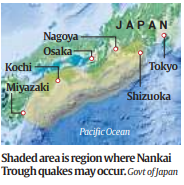
- Event: A 7.1-magnitude earthquake struck southern Japan.
- Response: Japan’s meteorological agency issued its first-ever “megaquake advisory.”
- Advisory Significance: Indicates a higher likelihood of strong shaking and large tsunamis in the Nankai Trough, but not a specific prediction.
- Nankai Trough Overview: A 900-km subduction zone where the Eurasian Plate meets the Philippine Sea Plate, known for producing megaquakes (magnitude 8+). Historically, it causes significant earthquakes every 100-150 years, often in pairs.
- Future Risks: Experts estimate a 70% chance of a magnitude 8-9 earthquake in the next 30 years. Potential impacts include widespread damage, tsunamis up to 98 feet high, and economic losses up to $1.5 trillion.
- Limitations of Prediction: Earthquake prediction remains scientifically unfeasible; the advisory focuses on preparedness rather than an imminent prediction.
About Nankai Trough:
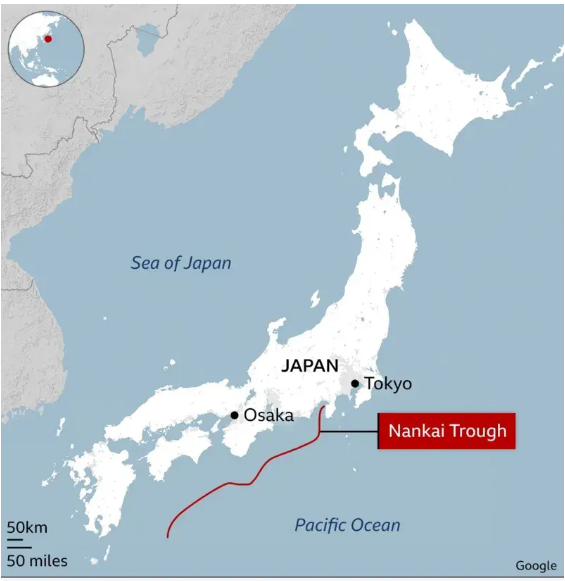
- It is a “subduction zone” between two tectonic plates in the Pacific Ocean, where massive earthquakes have hit in the past.
- This underwater subduction zone (nearly 900 km long) where the Eurasian Plate collides with the Philippine Sea Plate, pushing the latter under the former and into the Earth’s mantle.
- Location: It runs from Shizuoka, west of Tokyo, to the southern tip of Kyushu Island.
- It has been the site of destructive quakes of magnitude eight or nine every century or two.
- These so-called “megathrust quakes”, which often occur in pairs, have been known to unleash dangerous tsunamis along Japan’s southern coast.


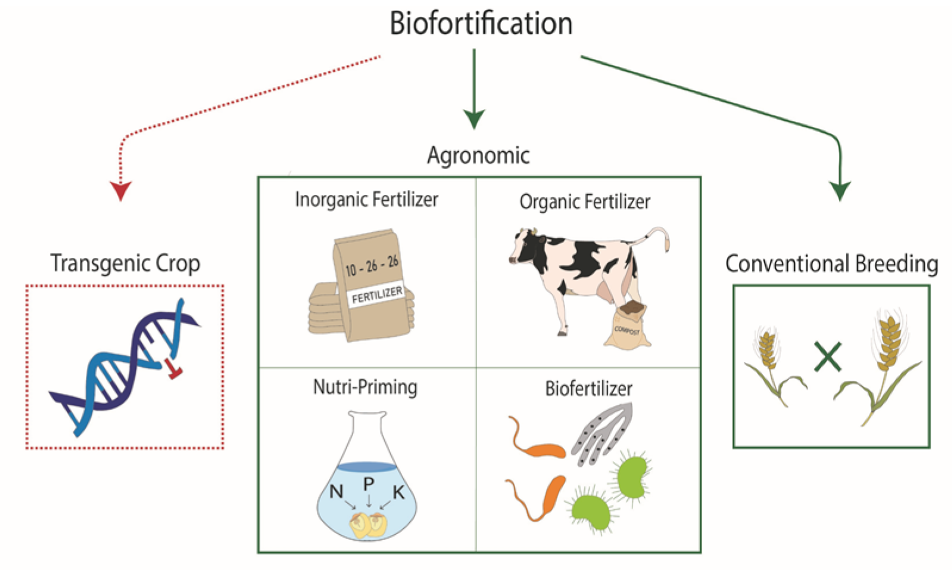
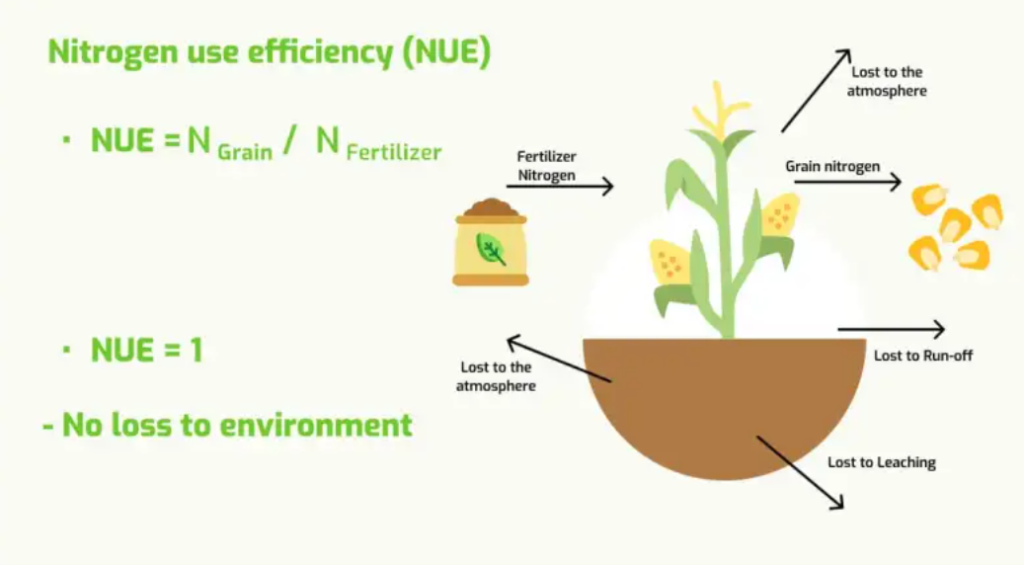 Nitrogen Use Efficiency (NUE) refers to the effectiveness with which a plant utilises available nitrogen—both natural and synthetic—for growth and yield.
Nitrogen Use Efficiency (NUE) refers to the effectiveness with which a plant utilises available nitrogen—both natural and synthetic—for growth and yield.
